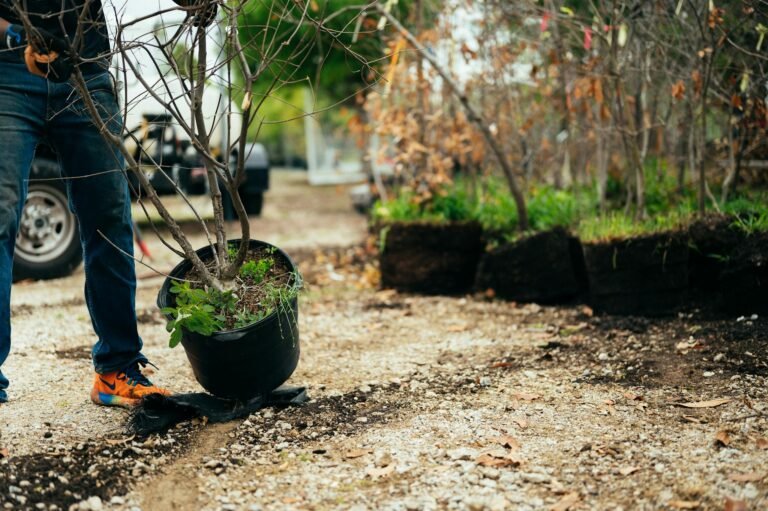Imagine a garden where every bloom and plant sparks joy. Dream gardens are for anyone who loves spending time outside. This guide shows 10 unique styles, from colorful cottage gardens to peaceful Zen retreats. It proves that garden design can be simple yet beautiful.
Adeline Kong’s garden in British Columbia is a great example. She started with a simple lawn in 2015 and added vibrant plants like marigolds and zinnias. Her key to success? Focusing on color and where to place plants.
“If it makes you happy, it works,” she says. She uses plants that are easy to care for, like drought-resistant Agastache ‘Blue Boa’ and deer-resistant Yarrow ‘Peter Cottontail’. Even small spaces can look amazing with her DIY ideas, like using divided perennials and seeds.
Key Takeaways
- Explore 10 garden styles, from wildflower meadows to formal topiaries.
- Begin with affordable plants like Yarrow or Butterfly Milkweed that thrive in various climates.
- Adeline’s success shows even small budgets can create stunning outdoor living spaces.
- Colorful annuals and perennials like zinnias or Monkshood add instant visual impact.
- Every garden profile includes maintenance tips for low-cost, high-impact design.
English Cottage Garden – Overflowing with colorful blooms, winding paths, and charming rustic touches.
Imagine stepping into a garden where flowers spill over stone paths and roses cling to weathered fences. English cottage gardens are full of flower beds that are alive with color. They mix wild and cultivated beauty, making any space charming, whether it’s big or small.
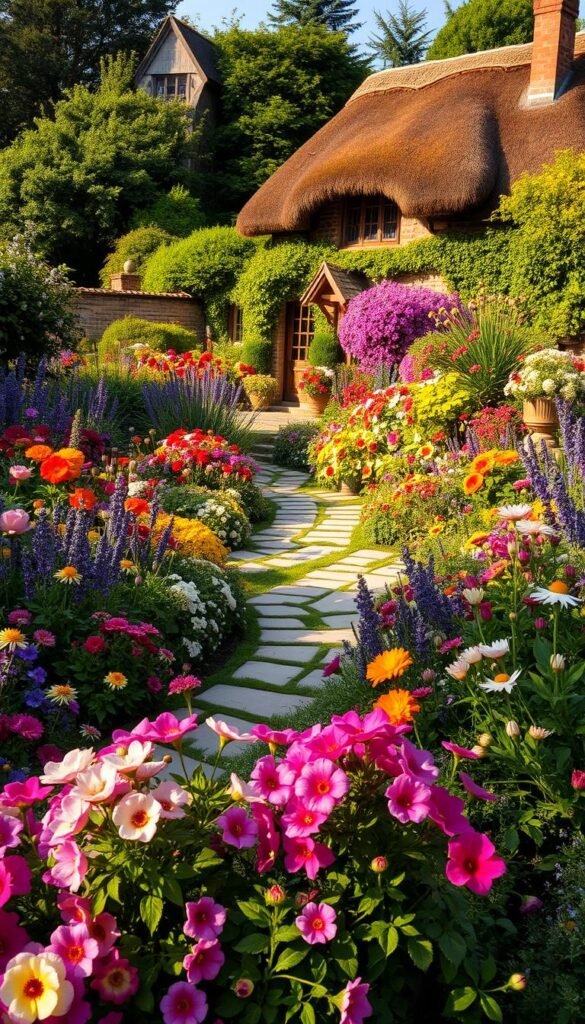
Creating Cottage Garden Magic in Your Backyard
Begin by choosing plants that look like they grew wild. Mix tall delphiniums and foxgloves with daisies and creeping thyme. Add climbing roses to trellises for height. Follow these steps to create your own garden paradise:
- Plant in drifts: Group similar flowers for a natural look
- Mix annuals like pansies with perennials like lavender for year-round color
- Leave space for herbs—rosemary and basil add fragrance and function
Use landscaping ideas like winding gravel paths or a cozy bench to create inviting spots. Add vintage touches like a rusted gate, terracotta pots, or a mosaic birdbath. Let plants soften the edges of hardscapes, like ivy over stone walls.
| Plant Type | Examples |
|---|---|
| Tall Backdrops | Hollyhocks, sunflowers, sweet peas |
| Middle Layer | Zinnias, cosmos, lavender |
| Ground Covers | Pansies, creeping thyme, alyssum |
Embrace a bit of “messy” beauty—let plants self-seed and spill over borders. With these elements, your garden will bloom with cottage-style charm all season long.
Japanese Zen Garden – Minimalist beauty with raked gravel, stone features, and tranquil water elements.
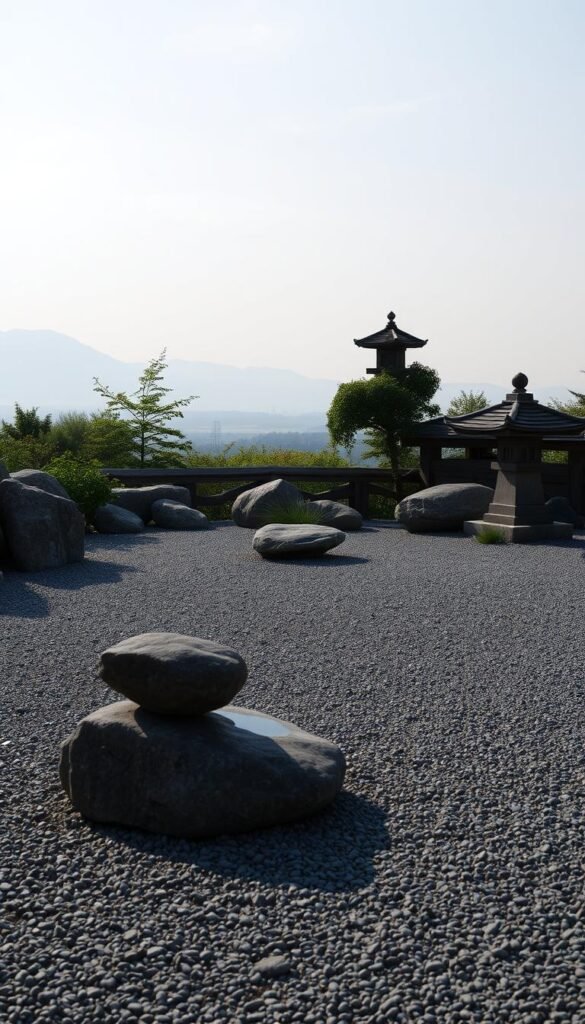
Turn your outdoor area into a peaceful haven with Japanese Zen garden design. These spaces are simple yet powerful, creating a place for quiet reflection. Unlike lush gardens, Zen gardens focus on empty space and symbols that encourage mindfulness.
Finding Peace in Zen Garden Simplicity
Core elements shape every Zen garden:
- Raked gravel mimics water movement, with patterns like waves or concentric circles.
- Weathered stones and boulders symbolize mountains, grounding the design.
- Water features like bamboo fountains add gentle sound without visual clutter.
- Moss and evergreens like Japanese maple anchor the space with timeless greenery.
| Element | Symbolic Meaning |
|---|---|
| Rocks | Strength and permanence |
| Gravel | Flowing water and change |
| Moss | Timelessness and tranquility |
| Water | Purity and renewal |
Starting a Zen garden is about scale. It can be a full backyard or a small corner. Use gravel paths to lead to key spots like a single stone or mossy boulder. Choose plants like Pachysandra or a Bloodgood Japanese maple for color.
Raking gravel daily is a calming activity. It helps reduce stress, just like gardening with natural elements does for 75% of gardeners.
Balance is key in Zen gardens. Pair rough stones with smooth ones, following yin-yang principles. Even a small water basin or wind chime can make a big impact. These designs show that simplicity is the path to peace outdoors.
Mediterranean Courtyard Garden – Terracotta pots, lavender, olive trees, and cozy seating under a pergola.
Mediterranean courtyards love the sun and simple beauty. Terracotta pots overflow with geraniums, and olive trees create cozy spots. These outdoor living spaces have natural stone patios and pergolas for a perfect retreat.
Details like gravel paths and herbs add to the charm. They remind us of Mediterranean life’s timeless beauty.
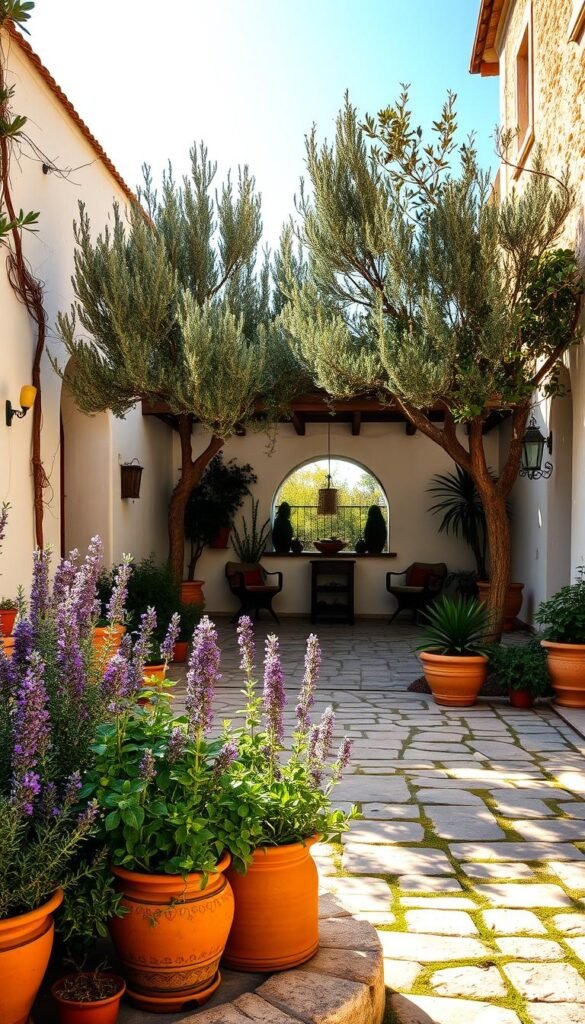
Mediterranean gardens are living stories of resilience and joy, where every plant choice tells a tale of place and tradition.
Bringing Mediterranean Warmth to Your Outdoor Space
- Plant lavender and rosemary for year-round fragrance and low-water needs
- Use natural stone for patios to mirror traditional Mediterranean materials
- Train vines like jasmine over pergolas to cast cooling shade
Sustainable gardening is key here. Plants like thyme and sage need little water. Mix citrus trees with hardy plants for a beautiful look.
Garden maintenance is easy. Prune olive trees lightly and mulch annually to keep soil moist. In cold areas, mulch protects herbs like basil.
A small fountain adds sound without wasting water. Mosaic tiles in walkways bring color without needing much care. Each piece, from a stone bench to a clay pot of sage, makes the space inviting and easy to enjoy.
Tropical Jungle Garden – Lush greenery, bold foliage, and vibrant flowers that create a private paradise.
Turn your yard into a tropical jungle garden, a backyard retreat full of exotic life. This dream garden thrives with bold plants and layered design. It invites you to a rainforest-inspired sanctuary right at home.
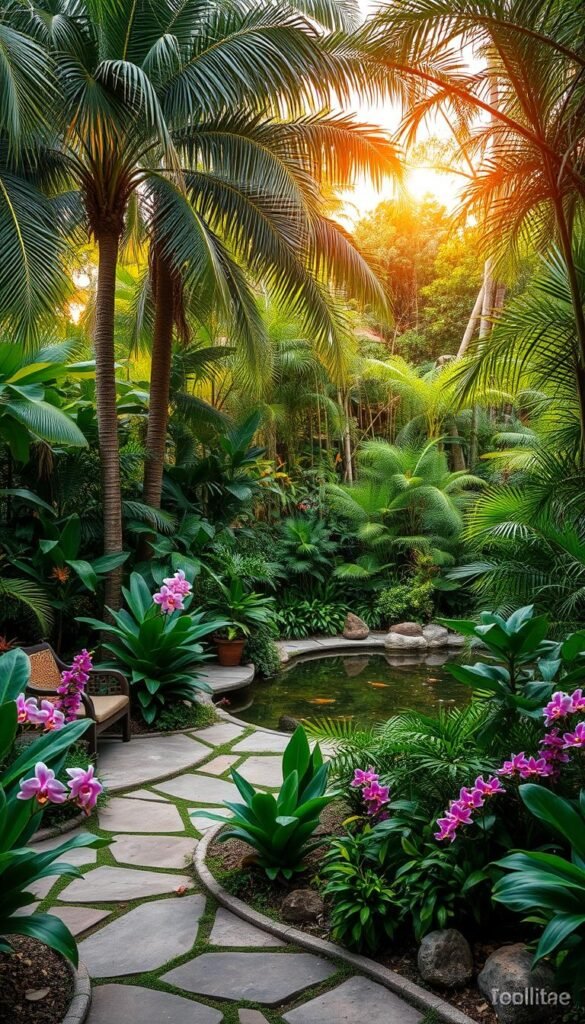
Creating Your Own Tropical Paradise
Start with careful plant selection to mimic nature’s layers. Use towering palms or bamboo as the canopy. Mid-level shrubs like crotons fill gaps, while ground covers like liriope or creeping jenny soften the base. Vines like passionflower or star jasmine add vertical drama.
- Banana plants and giant bird of paradise for dramatic height
- Caladiums and elephant ears for bold leaf patterns
- Annuals like marigolds or impatiens to fill empty spaces with color
Design elements make the escape complete. Add a small pond or tabletop fountain for calming sounds. Wicker loungers or a bamboo pergola anchor seating areas. String lights or solar-powered lanterns cast a warm glow at night.
In colder areas, grow tender plants in containers. Move them indoors in winter. Use mulch to keep moisture in and prune dead growth often. Hardy alternatives like hostas or Japanese fatsia mimic tropical foliage in frost-prone zones.
Every detail, from water features to palm fronds, creates an immersive space. This jungle oasis is a year-round sanctuary. It blends bold plants with practical design for a retreat that feels far from daily life.
Modern Minimalist Garden – Clean lines, geometric layouts, and sleek materials for a contemporary vibe.
Modern minimalist gardens are peaceful retreats where every piece has a role. They use landscaping ideas that mix simplicity with purpose. This makes outdoor living spaces both chic and calm.
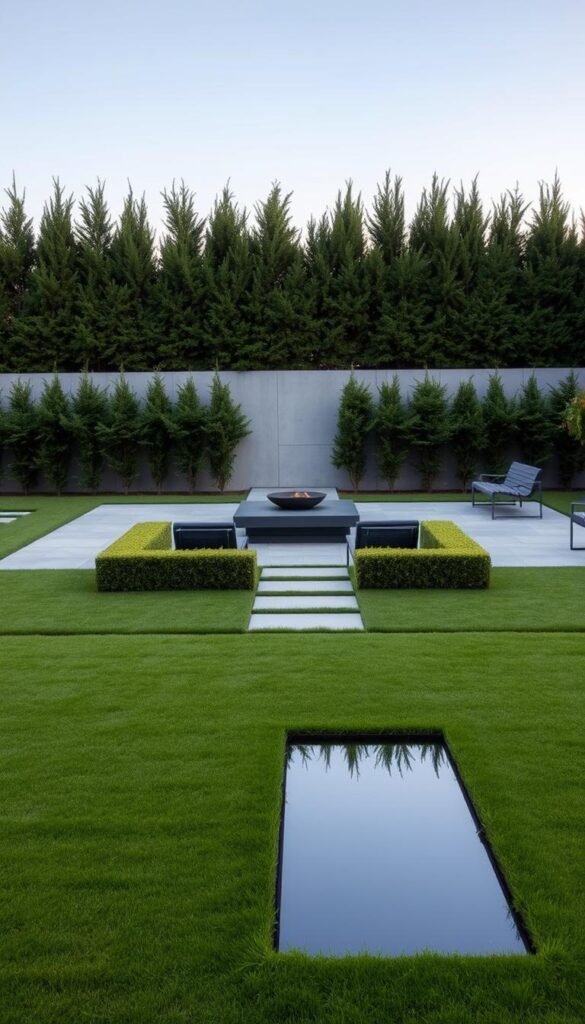
Designing with Simplicity and Intention
Minimalist garden design follows key rules:
- Clean lines and geometric patterns for visual harmony
- Neutral color schemes with pops of greenery for contrast
- Strategic use of negative space to emphasize focal points
| Material | Benefits | Common Uses |
|---|---|---|
| Corten Steel | Rustic patina, weather-resistant | Planters, fencing, structural accents |
| Exposed Concrete | Modern texture, durable | Patios, walkways, retaining walls |
| Blackedout Glass | Light-refracting, sleek appearance | Screen walls, water features |
Choosing plants like Bamboo and Boxwood is key. They keep their shape with little care. LED lights add drama at night, making the garden come alive.
Keeping up with this style means regular plant shaping and material care. But the result is a space that feels both timeless and vibrant. Every part, from concrete paths to steel details, has a purpose in this elegant yet welcoming design.
Fairy Tale Woodland Garden – Enchanted pathways, mossy rocks, and whimsical details hidden among the trees.
Turn shaded spots into magical worlds with garden design that mixes nature and fantasy. Paths made of flagstone or pea gravel lead to surprises at every turn. Imagine glowing mushrooms, tiny houses in ferns, and lights that sparkle like fireflies at night.
“Now in thinking about a secret garden, I find that you need some sort of path. It could be brick, pea gravel or perhaps flagstone.”
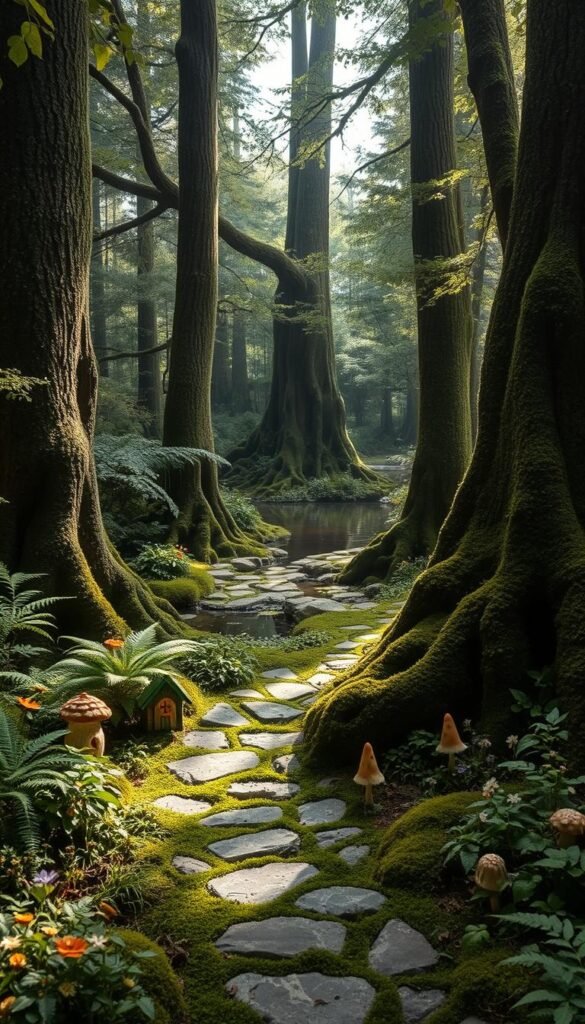
Creating Magical Moments in Shady Spaces
Begin by using landscaping ideas that respect the trees. Line paths with mossy stones or arrange logs for seating. Hostas and bleeding hearts grow well in low light, and miniature bluegrass makes a soft groundcover.
Add charm with DIY projects:
- Fairy doors on tree trunks
- Twig archways with twinkling lights
- Stone cottages with subtle glitter
Choose natural materials for a rustic look. Stack river rocks to frame pools or drape ivy over driftwood. Glow sticks in shrubs mimic magic without wiring. Carve tiny windows in stumps or bury jars with colored glass “treasures.”
Even small areas can be magical with texture and scale. Let fallen leaves be “carpets” and vines climb freely. The aim is to spark curiosity—every corner has a story to tell.
Desert Succulent Garden – Drought-tolerant cacti and succulents artfully arranged for a low-maintenance haven.
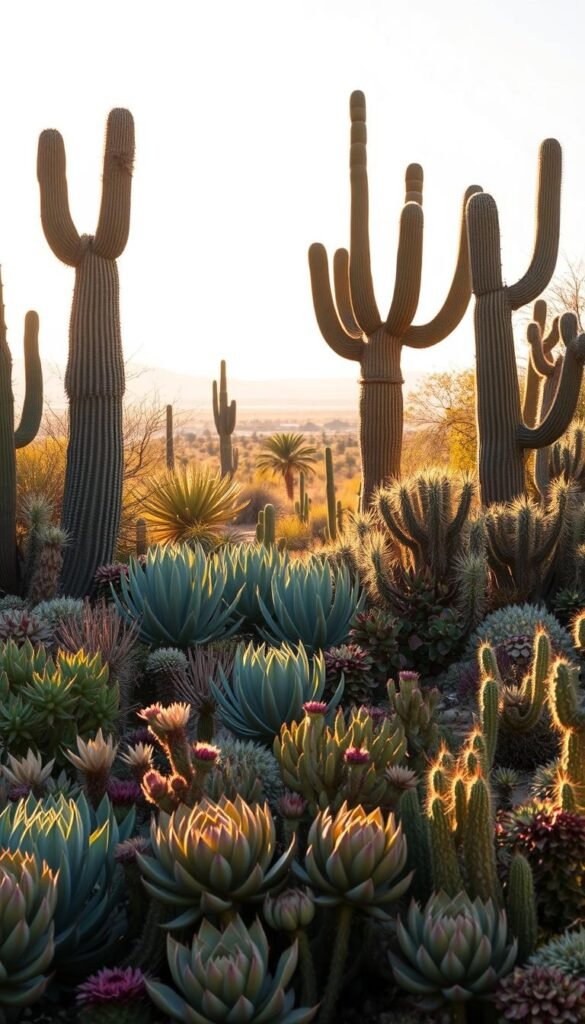
Turn dry areas into dream gardens with desert succulents. These plants love dry spots, making them perfect for saving water. They come in all shapes, from big cacti to small rosettes, helping your garden look great while saving water.
Embracing Sustainable Beauty in Arid Landscapes
Use plants like Agave parryi ‘truncata’ and Echinocactus grusonii for bold looks. Add Hesperaloe parviflora for color all year. These plants need very little water, great for those who care about the planet.
- Artichoke Agave: Blue-gray rosettes with dramatic maroon edges
- Golden Barrel Cactus: Round yellow forms perfect for group plantings
- Red Yucca: Coral blooms and grass-like foliage add texture
Make your garden look good with gravel paths and boulders. The Huntington Library’s Desert Garden shows how. Use hypertufa containers at Ft. Collins’ Gardens on Spring Creek for creative displays. Make sure the soil drains well to avoid root rot.
Tip:Water deeply but not often. Mulch like crushed granite helps keep moisture in and looks nice.
Use Feng Shui to place Desert Cacti by doors for protection. Add Midnight ceramic pots for a modern look. These plants are easy to care for, making your garden simple to maintain.
Grow more plants from cuttings to save money. Desert succulents are perfect for any space, showing that beauty and saving water can go together.
Vertical Urban Garden – Innovative use of walls and vertical planters, perfect for small spaces.
Urban living doesn’t mean you have to give up on greenery. Vertical garden design turns walls into canvases for lush foliage and blooms. This makes the most of tight spaces. You can grow plants on balconies or use them as living privacy screens.
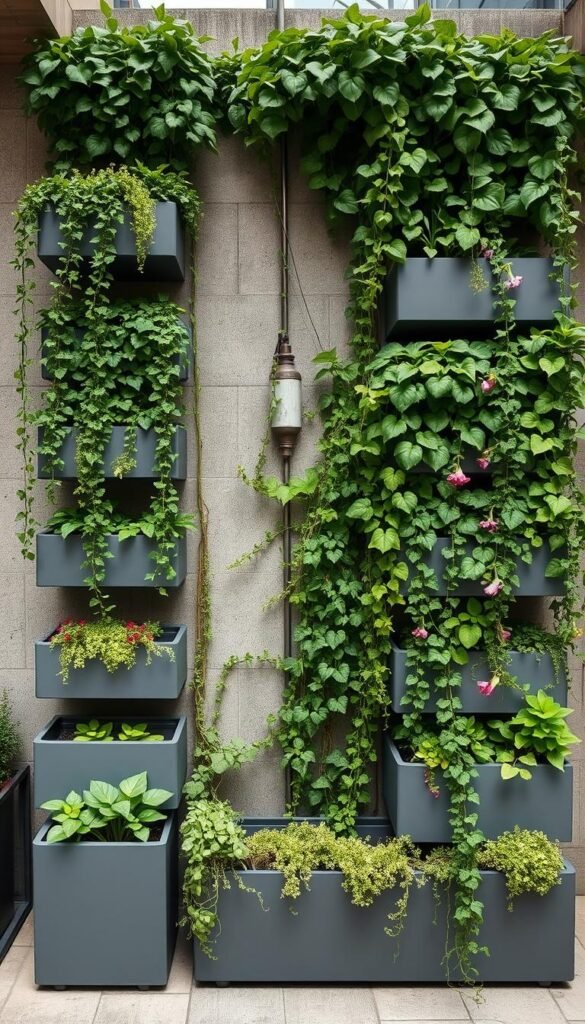
Varden Vertical Gardens show that even small patios can thrive. Their soil-based systems and drip irrigation ensure plants get water without waste. You can grow herbs, trailing flowers, or veggies like strawberries in these small-space flower beds stacked vertically.
“Break up space with trellises, obelisks, or chairs to add structure to vertical layouts,” say landscape pros.
DIY gardening enthusiasts can start simple:
- Repurpose gutters or pallets into hanging planters
- Mount modular planters on fences or walls
- Pair trailing plants like pothos with upright succulents for layered interest
Lightweight potting mixes prevent soil compaction. Materials like recycled plastic or metal keep planters durable. Whether modern or rustic, vertical setups fit any style. Plus, these designs cut pest issues and make harvesting herbs or blooms effortless.
From HGTV’s Rock the Block to Coachella’s installations, vertical gardens prove their versatility. Turn empty walls into living art that cleans the air, muffles noise, and adds privacy—all without sacrificing style.
French Formal Garden – Symmetry, topiaries, and gravel paths that reflect classic elegance and refinement.
French formal gardens are known for their grandeur and structure. They follow the design of Versailles, blending art with order. The gravel paths and clipped hedges show the beauty of garden design principles.
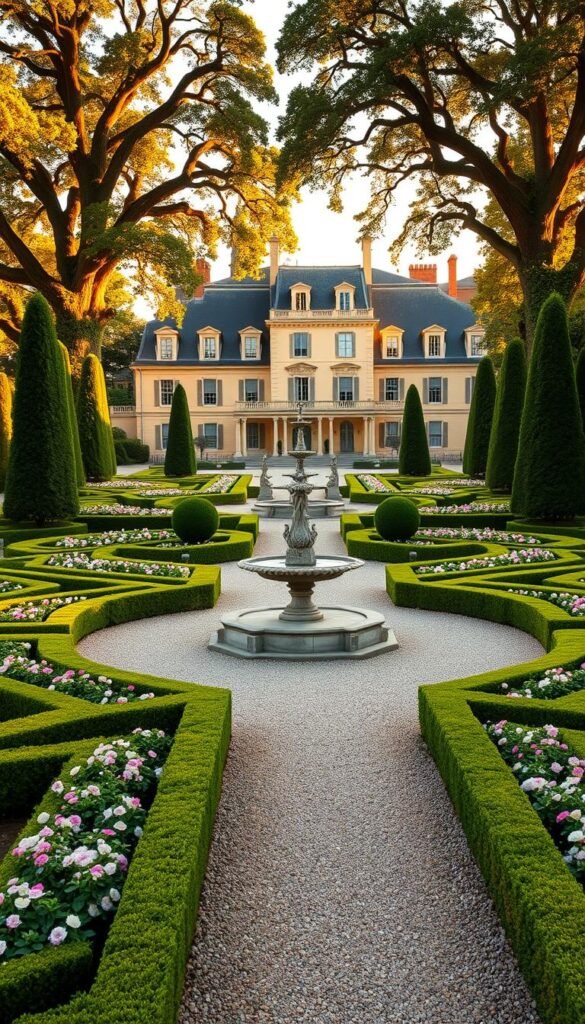
Creating Timeless Structure and Sophistication
“A well-crafted formal garden is a living blueprint of discipline and beauty.” – André Le Nôtre, architect of Versailles”
These gardens focus on geometric shapes. Start by drawing paths with straight lines and right angles. Use boxwood balls or yew topiaries for landscaping ideas.
For smaller areas, use dwarf shrubs and compact gravel beds. Garden maintenance includes regular clipping and weeding out invasive plants like bindweed.
- Plan symmetry first: Lay out paths with a garden hose to visualize lines before planting.
- Select plants that respond to shaping: Boxwood and hornbeam thrive under pruning for topiary forms.
- Combat weeds early: Use herbicides for Bermuda grass or hand-pull bindweed roots to prevent spread.
Modern updates make these gardens easier to care for without losing their charm. You can use simpler geometric beds or synthetic gravel for paths. Even small yards can have a focal point, like a fountain or symmetrical hedge pair.
Wildflower Meadow Garden – A vibrant, naturalistic space full of pollinator-friendly flowers and gentle movement.
Wildflower meadows turn outdoor spaces into living ecosystems. They support nature while being beautiful. These gardens use native plants like hosta and creeping phlox, making them bloom all year.
They attract pollinators like monarch butterflies and honeybees. This reduces the need for harmful pesticides. Even small areas can become vibrant habitats with careful planning.
Embracing Ecological Beauty and Biodiversity
Ecological balance is key in these gardens. Plants like yellow trillium and Solomon’s seal grow well without much care. Their roots help prevent soil erosion, and they look interesting all year.
Choosing native plants boosts local biodiversity. For example, bugleweed keeps weeds away while attracting pollinators. This shows that beauty and sustainability can go hand in hand.
Design your borders with mown paths to highlight the beauty. Use a mix of flowers that bloom at different times. This creates a natural look that’s both wild and beautiful.
DIY gardening makes it easy to start. Use seed balls to spread native seeds in new areas. Build insect hotels from wood scraps or leave dead stems for shelter. These simple steps can turn any space into a wildflower paradise.
Wildflower meadows are more than just pretty. They’re essential for ecosystems and bring joy into our lives. Start small by adding milkweed or a pollinator mix to your garden. Every step towards ecological gardening makes a difference.





